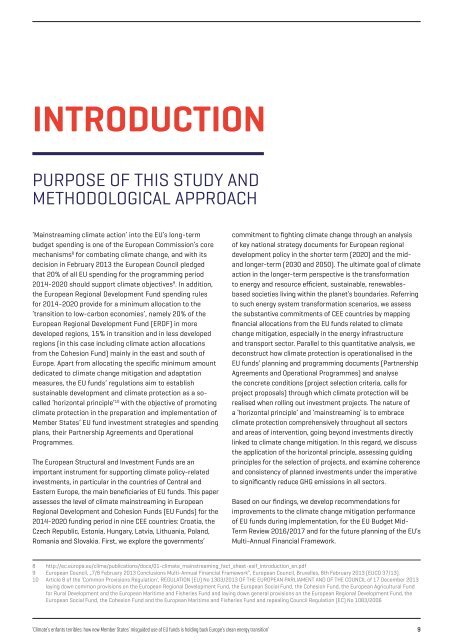ENFANTS TERRIBLES
enfants-terribles
enfants-terribles
You also want an ePaper? Increase the reach of your titles
YUMPU automatically turns print PDFs into web optimized ePapers that Google loves.
INTRODUCTION<br />
PURPOSE OF THIS STUDY AND<br />
METHODOLOGICAL APPROACH<br />
‘Mainstreaming climate action’ into the EU’s long-term<br />
budget spending is one of the European Commission’s core<br />
mechanisms 8 for combating climate change, and with its<br />
decision in February 2013 the European Council pledged<br />
that 20% of all EU spending for the programming period<br />
2014-2020 should support climate objectives 9 . In addition,<br />
the European Regional Development Fund spending rules<br />
for 2014-2020 provide for a minimum allocation to the<br />
‘transition to low-carbon economies’, namely 20% of the<br />
European Regional Development Fund (ERDF) in more<br />
developed regions, 15% in transition and in less developed<br />
regions (in this case including climate action allocations<br />
from the Cohesion Fund) mainly in the east and south of<br />
Europe. Apart from allocating the specific minimum amount<br />
dedicated to climate change mitigation and adaptation<br />
measures, the EU funds‘ regulations aim to establish<br />
sustainable development and climate protection as a socalled<br />
‘horizontal principle’ 10 with the objective of promoting<br />
climate protection in the preparation and implementation of<br />
Member States‘ EU fund investment strategies and spending<br />
plans, their Partnership Agreements and Operational<br />
Programmes.<br />
The European Structural and Investment Funds are an<br />
important instrument for supporting climate policy-related<br />
investments, in particular in the countries of Central and<br />
Eastern Europe, the main beneficiaries of EU funds. This paper<br />
assesses the level of climate mainstreaming in European<br />
Regional Development and Cohesion Funds (EU Funds) for the<br />
2014-2020 funding period in nine CEE countries: Croatia, the<br />
Czech Republic, Estonia, Hungary, Latvia, Lithuania, Poland,<br />
Romania and Slovakia. First, we explore the governments’<br />
commitment to fighting climate change through an analysis<br />
of key national strategy documents for European regional<br />
development policy in the shorter term (2020) and the midand<br />
longer-term (2030 and 2050). The ultimate goal of climate<br />
action in the longer-term perspective is the transformation<br />
to energy and resource efficient, sustainable, renewablesbased<br />
societies living within the planet’s boundaries. Referring<br />
to such energy system transformation scenarios, we assess<br />
the substantive commitments of CEE countries by mapping<br />
financial allocations from the EU funds related to climate<br />
change mitigation, especially in the energy infrastructure<br />
and transport sector. Parallel to this quantitative analysis, we<br />
deconstruct how climate protection is operationalised in the<br />
EU funds’ planning and programming documents (Partnership<br />
Agreements and Operational Programmes) and analyse<br />
the concrete conditions (project selection criteria, calls for<br />
project proposals) through which climate protection will be<br />
realised when rolling out investment projects. The nature of<br />
a ‘horizontal principle’ and ‘mainstreaming’ is to embrace<br />
climate protection comprehensively throughout all sectors<br />
and areas of intervention, going beyond investments directly<br />
linked to climate change mitigation. In this regard, we discuss<br />
the application of the horizontal principle, assessing guiding<br />
principles for the selection of projects, and examine coherence<br />
and consistency of planned investments under the imperative<br />
to significantly reduce GHG emissions in all sectors.<br />
Based on our findings, we develop recommendations for<br />
improvements to the climate change mitigation performance<br />
of EU funds during implementation, for the EU Budget Mid-<br />
Term Review 2016/2017 and for the future planning of the EU’s<br />
Multi-Annual Financial Framework.<br />
8<br />
9<br />
10<br />
http://ec.europa.eu/clima/publications/docs/01-climate_mainstreaming_fact_sheet-esif_introduction_en.pdf<br />
European Council, „7/8 February 2013 Conclusions Multi-Annual Financial Framework”, European Council, Bruxelles, 8th February 2013 (EUCO 37/13).<br />
Article 8 of the ‘Common Provisions Regulation’, REGULATION (EU) No 1303/2013 OF THE EUROPEAN PARLIAMENT AND OF THE COUNCIL of 17 December 2013<br />
laying down common provisions on the European Regional Development Fund, the European Social Fund, the Cohesion Fund, the European Agricultural Fund<br />
for Rural Development and the European Maritime and Fisheries Fund and laying down general provisions on the European Regional Development Fund, the<br />
European Social Fund, the Cohesion Fund and the European Maritime and Fisheries Fund and repealing Council Regulation (EC) No 1083/2006<br />
‘Climate’s enfants terribles: how new Member States’ misguided use of EU funds is holding back Europe’s clean energy transition’ 9


